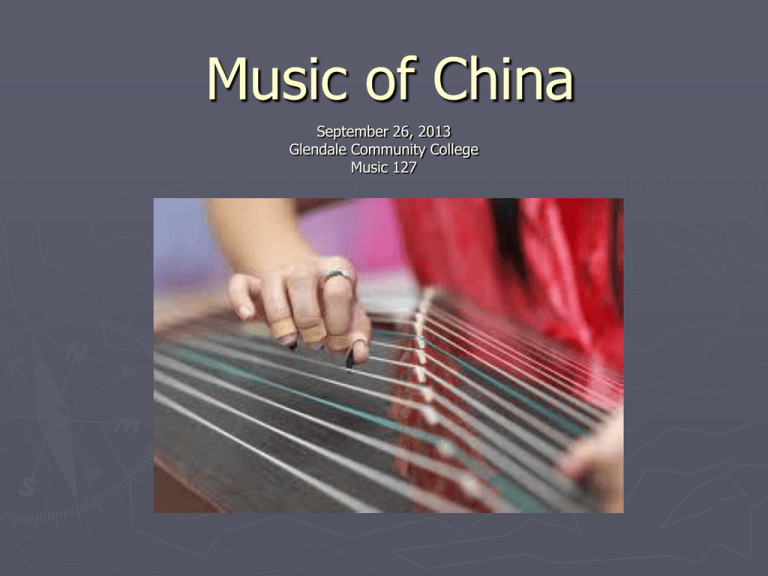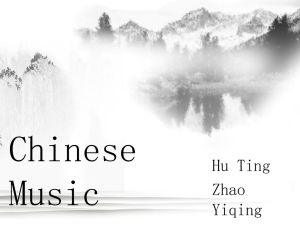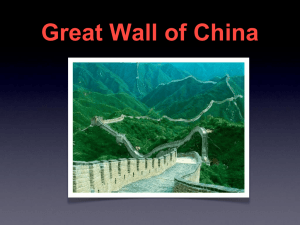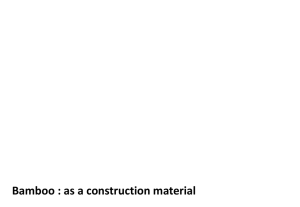
Music of China
September 26, 2013
Glendale Community College
Music 127
Lecture Assignment
► Please
read the assigned chapter first, 4 The Music
of China.
► Then, read through this lecture, follow any links
and listen to any music I have posted.
► Throughout the lecture you will find questions.
Please answer each question based on the
reading, lecture and any outside research I ask
for.
► Finally, send me your answers by pasting them
into the body of an email. Due before Friday,
October 4.
psherman@glendale.edu
Political map
China in the World
► Pick
one of these topics and discuss in a
short essay China’s:
► Support
of N. Korea;
► Support of Iran and Syria as allies of Russia;
► Economic Development in Africa, Central
and South America;
► Trial of Bo Xilai;
Chapter Overview
►
China has a long musical tradition documented in
historical and notated sources. Traditional Chinese music
depends more on memorization, repetition, idiomatic
realization, and embellishment of standard instrumental
pieces, rather than on improvisation. The music for Peking
(or Beijing) Opera contains sound codes that emphasize
the drama created by combinations of instruments. While
Confucianism revered proper sounding music for inducing
correct social behavior in ancient times, the Communist
Chinese in the 20th century exercised a similar philosophy
by filling songs with propaganda. Much Chinese music and
many of its instruments derived from interactions of the
numerous minorities over thousands of years, and their
music further developed into standard repertories.
Ethnic Population
►A
Billion and a Quarter People, Includes 56
Recognized Minorities
► Han
–– the world’s largest ethnic group that
comprises more than 93% of China’s population
► Putuaghua –– the Han language, in the West
known as Mandarin
► Zhuang, Mongolian, Manchu, Tibetan, Hui,
Uyghur, Kazak, Tarter, Kirgiz, Tajik, Uzbek peoples
Beijing
► Capital
municipality of the People’s Republic
of China
► Bei –– means, “north”; jing means,
“capital”
► Yuan Dynasty (1206-1368), Ming Dynasty
(1368-1644), Qing Dynasty (1644-1911)
based in Beijing
Important Music Terms
► Jingju
–– literally “capitol theater”, Peking Opera –
– the main type of Chinese popular musical
theater that first emerged in the Chinese capital
Beijing (Peking) in the late eighteenth century
► Liyuan –– literally “Pear Garden,” the metaphor
for “theater”
► Qing chang –– singing without staging, costume,
or make-up, practiced publicly by jingju fans
► Jinghu –– literally “capital fiddle”; a two-string
spiked fiddle, the principal melodic instrument in
jingju
► Nan ban zi –– an aria introduction played by a
jinghu
► Qin
(pronounced chin) –– a Chinese sevenstringed zither most revered and patronized
by the educated class. Originally an
instrument for court music (elegant music;
yayue), it later came to be played in privacy
by scholars for contemplation, selfpurification, and self-regulation. It has no
frets or bridges, but thirteen positionmarkers called hui.
The Qin (Quqin) and Its Music
Formal Structure of a Qin piece
► Sanqi
–– introduction to a qin piece (0-37”)
► Rudiao –– the exposition of a qin piece (37-1:40)
► Ruman –– the variations section, or development,
of a qin piece (1:40-5:00)
► Fuqi –– restatement of the theme (5:00-6:56)
► Weisheng –– literally “tail sounds”; the short coda
that concludes a qin piece, using the strings’
harmonics produced by lightly touching the strings
(6:56-end)
Definitions
► Introduction
– Music that comes before the main
piece to put the listener in the proper frame of
mind.
► Exposition – The first hearing of the main theme
or themes.
► Variations – Alterations to the themes stated in
the exposition.
► Development – building on the themes stated
above.
► Coda – A short ending or conclusion.
Flowing Water
http://www.youtube.com/watch?v=B8F0G4QEQYg
Questions
► Based
on your reading of the text and
listening to the above example, do you think
this music is composed or improvised?
► Please explain your answer.
The Pipa and Its Music
► Pipa
–– a four-stringed, fretted lute with a
bent neck and pear-shaped body; an
imported instrument to Han China, originally
from the Kucha Kingdom (an ancient
Uyghur kingdom). It developed an
important repertory by the time of the Sui
and Tang periods (581-618 and 618-905). It
has 23 to 25 frets placed along the neck
and the sound board. Its pieces have
programmatic titles.
Programmatic vs Absolute Music
– tells a ► Absolute – pure music
with no “extra”
story through music.
meaning. http://www.
► http://www.youtube.co
youtube.com/watch?v
m/watch?v=bGXBIThp
=KwNonij12tQ
1g4
► Programmatic
Types of Pipa Music
► Yan
yue –– banquet entertainment music
► Wen
► Wu
–– lyrical, civil
–– martial
Example 1
http://www.youtube.com/watch?v=JtrthXXmKgA
Example 2
http://www.youtube.com/watch?v=jXvNgl5Yq2U
Questions
► Should
example 1 be classified as an
example of yan yue, wen or wu and why?
(based on slide 19 and your exploration of
the example)
► Example 2, same question.
► Into which formal classification would you
place the qin and the pipa? Be very specific.
Winds and Strings Ensembles in
Shanghai
► Jiangnan
sizhu—a type of Chinese chamber
instrumental ensemble made up of strings and
winds, popular in the areas around Shanghai
► Jiangnan –– literally means, “south of the river,”
in reference to the Yangzi River
► Si –– literally means, “silk”; in reference to string
instruments (strings were once made of silk, but
now made of steel for louder volume)
► Zhu –– literally means, “bamboo”; in reference to
wind instruments made of bamboo
Jiangnan sizhu ensemble
Strings
pipa (see slide 20)
sanxian (three-stringed lute with long, fretless
neck and oval sound box. video below)
http://www.youtube.com/watch?v=pyJe0HdxCy
k
erhu (two-stringed fiddles with hollow wooden
cylindrical sound boxes having one side covered with
snake-skin) On the left in the video below
qinqin (lute with a long, fretted neck) In the center in
the video below
One yangqin (a dulcimer struck with a pair of
bamboo sticks)
http://www.youtube.com/watch?v=UW25
YUnOxA0
Winds
dizi (a transverse bamboo flute with six fingerholes, a mouth hole, and another hole covered
by a thin membrane that vibrates to give the
instrument a reedy sound)
http://www.youtube.com/watch?v=TxsOks4V35
w
sheng (a free-reed mouth organ made of a series of bamboo
pipes arranged in a circle, each with a reed in its lower end,
and all inserted into a base made of copper, wood, or gourd,
to which the mouthpiece is attached. Two or more tones may
be produced simultaneously.)
http://www.youtube.com/watch?v=SWt4mf3whxw
xiao (an end-blown bamboo flute with five
frontal finger-holes, one hole in the back, and a
blowing hole at the top) Begins at 24”
http://www.youtube.com/watch?v=eNzGLAGLL
uE
Jiangnan sizhu ensemble
http://www.youtube.com/watch?v=wfBJ6k2RtmY
Jingju Theater (Capital Theater, or
Peking Opera in the West)
► includes
arias, recitative-like short phrases,
and heightened speech
► Heightened speech - a stylized stage speech
with steeply rising and falling contours that
exaggerate the natural intonation of spoken
Chinese
Questions:
► Research
online or in library texts and
define, Aria and Recitative.
► In what western art forms are they used?
Jingju Theater (Capital Theater, or
Peking Opera in the West)
►
includes arias, recitative-like short phrases, and heightened
speech a stylized stage speech with steeply rising and
falling contours that exaggerate the natural intonation of
spoken Chinese http://www.youtube.com/watch?v=YSfwPa-w_E
Main Categories of Role
► Sheng
–– the male role
► Dan –– the female role
► Jing –– the painted face role
► Chou –– the male comic role
Mymusiclab example 1
► http://media.pearsoncmg.com/ph/hss/hss_n
ettl_worldmusic_6e/active_listening_guides/
index.html#nettl6e_alg13_ch04-lg
Mymusiclab example 2
► http://media.pearsoncmg.com/ph/hss/hss_n
ettl_worldmusic_6e/active_listening_guides/
index.html#nettl6e_alg14_ch04-lg
The Value and Functions of Music
► Musical
gratification is equated with the
taste for food, the need for sex, and
aesthetic satisfaction.
► Music is integrated into rituals, banquets,
weddings, funerals, harvest celebrations,
and so forth.
► Kong
Fuzi –– Master
Kong, known as
Confucius in the West
(551-479 B.C.E.). He
maintained that music
has positive and
negative powers to
stimulate related
behavior and desire.
Master Kong’s classifications
►
►
Shi yin –– proper sound,
features harmoniousness,
peacefulness, and
appropriateness
Chi yue –– extravagant
music, having attributes of
inappropriate loudness,
wanton noisiness,
stimulating excessive and
licentious behavior
► Mao
Zedong (18931976) –– Chairman of
the Communist Party
from 1949-1976, like
Confucius, viewed
music as an
educational tool,
applying it for the
propaganda of state
ideology
►
►
The Communists
discredited scholarly music
for its affiliation with
feudal society, but
promoted folk music as the
music of the workers.
Before 1949, professional
musicians had low social
status while the educated
amateur was revered.
Under Communism, the
opposite was regarded.
New Musical Directions in the 20th
Century
► Kang
Youwei (1858-1927) and Liang Qichao
(1873-1929) –– music educators who
established classroom music in China based
on Western models
► Xiao
Youmei (1884-1940) –– reformed
Chinese music by incorporating Western
elements, notably harmony
► Zhao
Yuanren (1892-1982) –– the creator of
the modern Chinese art song
► Songs
of the Masses –– Chinese Communist
political songs
http://www.youtube.com/watch?v=t5q4cL9
qZQI
► Jiang
Qing (19131991) –– wife of Mao
Zedong, who reformed
jingju by incorporating
elements of western
orchestral and
harmonic practice,
ballet, scenic design,
and replacing
traditional stories with
revolutionary plots
Cui Jian –– the most famous Chinese rock musician whose
music rejected the materialism that swept China in the 1980s,
culminating in the Tiananmen Square uprising in 1989
http://www.youtube.com/watch?v=kYwsPt854Xo
Zhong jinshu –– Chinese heavy
metal music
http://www.youtube.com/watch?v=sccTU1UD52c
Questions:
► How
do you think Master Kong would
classify the Communist Political songs?
► Give
some examples of how western music
is incorporated into the rituals of life.
Weddings, funerals, festivals, etc.
Key Concepts for the Unit
Importance of Written Language and
History:
►A
non-alphabetic ideographic script meant
that Chinese could be used by neighbors
with totally different languages, and that
classics written centuries earlier could be
understood by contemporary readers. This
led to a great regard for history, high status
for scholar-officials, and an imperial state
system based on bureaucracy. Each dynasty
had its own historical records, much of
which provided musical documentation.
Highly Specific Musical Systems with
Codification at Many Levels:
► This
includes stock character types in
theatrical genres, particular musical styles
used in specific contexts, instruments used
in standardized ensembles, solo
instrumental traditions, each with its own
special notation, repertoire, and idiomatic
technique.
Question:
► Name
one stock character from Chinese
opera and one standard ensemble of
instruments.
Music and Politics:
► Music
and politics have long been interconnected.
Confucius (551-479 B.C.E.) believed that proper
music (i.e., ritual music played in unison with long,
broad rhythms, slow tempo, and simple melodies)
was capable of promoting proper behavior, while
“extravagant music” (i.e., loud, fast music) could
stimulate excessive, licentious behavior. Mao
Zedong also believed in music as an important
educational tool for the propagation of state
ideology, rather than the expression of virtue.
Listening Skills
Heterophonic Ensemble Music:
► The
Jiangnan sizhu ensemble, like Middle
Eastern groups, comprises a small number
of different musical instruments. The music
is heterophonic, as there is no harmony,
just different renditions of the same tune,
each distinguished by its own sound texture
and by ornamentation specific to the
instrument.
Questions:
► Pick
out the tune in the following video by
humming it. Describe the sound
characteristic of each instrument and the
manner in which it ornaments the melody.
► How is the way in which it ornaments based
on the construction or basic “nature of each
instrument?
Jiangnan sizhu
http://www.youtube.com/watch?v=7TcVJViSksY
Summary
Chinese civilization dates back many centuries and includes
many different ethnic groups, cultures, and languages.
Key instruments include the qin (zither) and pipa (lute).
Traditional musical performances——such as tea house
music——are found in public places, performed by
amateurs and professionals alike; the audience comes and
goes as it pleases, often talking during a performance; and
the melodies are often highly improvised, with no
announced program.
Jingju (or Peking Opera) is one of China’s best known
theatrical/musical styles, featuring elaborate sets and
costumes, and a richly developed sung repertory.
“Good music” maintains the proper social order
and underlines the beliefs endorsed by the state;
“bad music” leads to improper behavior or to
criticism of the status quo.
The rise of Communism and the successful 1949
revolution introduced a new, didactic type of
music meant to instill the government’s core
message to the citizenry, drawing on Soviet
models.
As Chinese society has opened up somewhat
following the Cultural Revolution of the ‘60s and
early ‘70s, Western art music and popular songs
have become more accepted, although there
remains an “underground” of unacceptable
musical styles, many of which question the
validity of the state’s power.
Questions:
► In
what ways can we compare jingju to Western
opera or a Broadway musical?
► How is music used for propaganda in our country?
► How is music used to instill values in our country?
► Why did the Communists, during the Cultural
Revolution (1966-76), utilize Western musical
practices such as orchestration, harmony, ballet,
and scenic design, in spite of being anti- Western?








